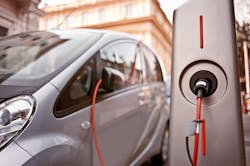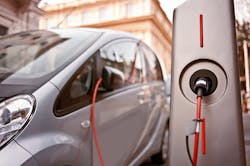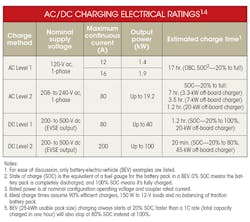Could Battery Swapping Ease Range Anxiety for EV Owners?
With electric vehicle (EV) sales climbing, people are starting to look at EVs as a viable driving option. Yet there are still concerns surrounding EVs for potential buyers. Mostly, those concerns center around the range and charging time of the batteries. Charge times are decreasing, but probably not as quickly as consumers would like. In the meantime, options from the past are showing up, such as battery swapping. Which option users choose depends on a few key factors, such as battery cost and charging/swapping time. Mostly, however, it comes down to the drivers and their habits.
The Battery
While some article headlines boast about battery breakthroughs, they are often small steps forward or spotlighting batteries designed for lower-voltage applications such as cellphones or laptops. EV battery performance does seem to be increasing, but this can often be due to other factors. “The Tesla 3 gets nearly double the range of the Nissan Leaf by using nearly double the amount of battery,” says Dr. Peter Harrop, chairman of IDTechEx. “But engineers are using a multitude of workarounds to improve EV range, charge times, and performance. Aerodynamics, light weighting, advanced structural electronics, supercapacitors, solid-state batteries, and more efficient motors and powertrain technology have all done a part in progressing EVs.”
Cost is another limiting factor. The battery is actually a several-thousand-dollar part. Mass production will eventually play a large roll in reducing battery price, but it also will inevitably increase the supply and demand for materials. According to the paper, “Life-cycle analysis for Lithium-Ion Battery Production and recycling,” published by Argonne National Laboratory in 2011, “…the Volt, a PHEV40, and the Leaf, a 100-mi all-electric, will require approximately 200% and 500% as much material, respectively. Recycling can reduce the material production by as much as 50%.” This will make recycling imperative to EVs. Mass production could justify setting up an infrastructure to streamline and/or automate the recycling processes to ensure a continuous flow of materials.
When considering what the EV driver wants, range anxiety—the worry associated with limited driving distance—is one of their primary concerns. Having to wait for technology to advance and people’s adoption of EVs to generate savings through mass production may not be what a potential buyer wants to hear. This is why some companies have been trying to find ways to make battery-swapping work well. According to Cleantechnica.com, Hartford Electric Company was swapping batteries on its electric trucks as far back as the early 1900s. Forklifts are no stranger to this technique either. And today, battery-swapping stations exist for buses all over China.
Battery Swapping
Using robotic automation to swap out batteries in minutes rather than waiting for a battery to charge sounds like a great way to defeat range anxiety. In five minutes, you could have an 80-mile battery swapped out and be back on the road. Swapping cost varies between battery packs. Some cost ranged from $80 to $100. Better Place, a battery swapping company, installed hundreds public charging outlets to help users get to the battery swapping stations they offered in multiple countries. Despite this, due to poor management and expanding too fast, Better Place declared bankruptcy in May 2013. Better Place’s story has not deterred Tesla Motors. Unveiling its battery-swapping station (only for Tesla models) in the same year as Better Place’s bankruptcy, Tesla supposedly placed its stations more strategically while taking about half the time to swap out a battery (roughly 90 seconds). Tesla also offers a pricing option to store your battery to make sure you get your battery back. This might help owners concerned with receiving a degraded or old battery.
One challenge that Tesla didn’t have to face was standardization. Because the company makes the car and the swapping stations, they dictate properties such as battery and battery fasteners. It would simply not be effective for each car manufacturer to have an independent station. Having all the EVs able to use one swapping station would be important, but that would add complexity. While automated systems could do this, car designers would have to communicate with the swapping stations as to where to put the batteries (along with type of fasteners, size, weight, etc.), torque capabilities of the robots, and inventory control to make sure a user pulling in will have a battery matching the cars model. Offering technicians to swap batteries has not been offered yet; automation, while capital-intensive, will likely have lower operating cost and liability over time. Automation works well in repetitive, tedious applications.
Batteries are a costly component of EVs. If swapping, customers will want to know if they are swapping a high-end battery with a lower-end battery. In 2011, MIT published a paper saying an EV’s battery could cost as much as 25% to 50% of the overall cost of a car. Today, replacement batteries for the Chevy Volt can be found online for about 8% to 12% of the car’s cost (this example is not from a dealer, and you would be responsible for installing it yourself, which could void warranties). Reducing battery cost will help swapping stations greatly as users will be concerned with swapping out a part that cost a couple thousand dollars.
“The suggested retail price of the Nissan LEAF battery pack is $5,499,” says Paige Presley of Nissan’s EV and technology communications. “This price includes and requires a return of your original battery pack valued at $1,000 to the dealer in exchange for the new battery. This price does not include tax, installation fees, or an installation kit required for 2011 and 2012 vehicles. However, dealers set the final pricing, so we recommend confirming with your local LEAF-certified dealer.” The 2016 Leaf has a manufacturer’s suggested retail price of $29,010. This still makes the battery about 22% of the car’s worth (considering the replacement would be $6,499 without the $1,000 core charge).
For battery swapping to grow, the following conditions should be met:
• Find strategic locations
• Standardized battery pack so one station can service all cars or design EVs with automated battery swapping in mind
• Continue to reduce battery cost while assuring customers that the battery they are receiving is just as good as the one they are leaving behind
Tesla has addressed these three points—at least for its cars. Despite this, swapping stations have an uphill battle. As EV range increases and charging becomes faster, many drivers might not mind getting out and stretching their legs for 20 minutes while the car charges (this time is based off of a DC level II charging station).
EV owners who live in cities or more developed areas are able to keep the battery charged by plugging in overnight, at the office, or other places that may even offer free charging. For most of them, this should cover the daily commute. The American Automobile Association published a study in April saying the average driver travels 29.2 miles a day. This is easily obtainable with the EVs currently on the market.
Range anxiety thus seems to arise more when planning or considering long trips. It might seem odd to have an extra car for a few trips throughout the year, but that is what some EV owners are considering—choosing to gas up on long trips instead of worrying about finding charging stations. This is where battery swapping might fit. By finding key locations between popular destinations, strategically placed stations can alleviate range anxiety. Users will drive the car onto a platform and, within minutes, have a full battery without ever having to exit the vehicle.
Effects on Batteries
Rapid charging may be a solution to longer trips but, along with high-load requirements, can decrease the life expectancy of the battery by adding stress. An advantage for swapping would be to charge batteries over time to reduce these stresses. Unfortunately, battery health is associated with the discharging cycle, too, and there is no incentive for drivers to swap a battery until it’s fully drained. Fully draining and recharging, even slowly, can degrade an EV’s battery faster.
Charging replacement batteries when it is most convenient could be beneficial. If the station manages its inventory well, it could use alternative energy onsite to recharge batteries. Solutions like this work well for developing nations without the infrastructure to have power—or consistent power. In addition, a battery-swapping station could use grid electricity when it is off-peak, cheapest, or when the more environmental energy generation is available. While charging overnight sounds like a good idea—it tends to be the cheapest time—evenings are also when many grids run on coal power that can greatly upset the environmental benefit of driving an EV.
Where battery-swapping stations may especially thrive is in companies with fleet vehicles. For example, China uses electric buses and swaps the batteries to keep cities moving. This seems contradictory to what was said earlier—that battery swapping does not work in more developed areas. However, fleet vehicles have found many benefits moving to EVs. Since companies make money by keeping the vehicles on the road, reducing a car or bus’s downtime with a swapping station may help boost productivity and profits.
Charging
Charging in general will mean EV owners will have to change the way they think. They might have to plan a little more on long road trips. This could bring many changes to commerce. With 20 minutes to refill, will roadside attractions become more lucrative? Will charging stations be overwhelmed during peak hours—making charging more annoying and giving swapping stations a leg up? Who owns the charger or the batteries, and how will money be distributed? These are questions we might have to wait for time to answer (if you have any thoughts, please leave a comment in the comment section below this article).
An article on ElectronicDesign.com, noted, “There are primarily two ways to transfer electricity from outside the vehicle to the battery inside: ac or dc. The grid transmits power in ac form, and energy stored in the on-board battery is in dc. Therefore, a charger is required to do the conversion job.
“Depending on whether the charger is installed inside of the vehicle or not, chargers can be categorized into on-board charger (OBC) and off-board charging station. An OBC accepts an ac power source from the main supply available at home and at the consumer’s workplace, and converts it to dc to charge the battery. Typically, ac charging is slow due to the charger’s limited power rating—a constraint arising from the limitations of allowable weight, space, and cost.
“The dc charging method is often used in off-board charging stations. It supplies regulated dc power directly to the batteries inside the vehicle. Because the dc charging equipment is installed at fixed locations with little constraint of size, its power rating can be as high as hundreds of kilowatts.
“For example, SAE J1772 specifies up to 100 kW for DC Level 2. CHAdeMO considers 50 kW to be optimal output power, taking into consideration both the cost of securing the maximum power at the charger location and the time it takes to charge the battery. Tesla’s Superchargers consist of multiple Model S chargers working in parallel to deliver up to 120 kW of dc power directly to the battery. This charging rate equates to 170 miles of range in about 30 minutes. The dc fast-charging method shortens the charging time from hours to minutes.”
The importance of OBC and off-board is not just a question of the electronics being on or off the vehicle, but what options a charging station offers. “General Electric is working on charging stations that will accommodate all the EVs on the road,” says Seth Cutler, general manager, EV Infrastructure at Current, from GE. “Standards and communication with the EV manufacturers is important to make sure our charging stations will accommodate everyone today and whatever EVs are produced in the future.”
Charging Levels
The U.S. Department of Energy presented the different levels of charging in a simplified version …
ac level 1 = two to five miles per hour of charge
ac level 2 = offers 10 to 20 miles of range per hour of charge
dc level 2 = 50 to 70 miles per 20 minutes of charging
The Department of Energy didn’t publish a range or time for DC level 1 in this manner.
Charging stations are the dominate way of powering EVs and look as though it will stay that way. Range anxiety will take some planning and perhaps more innovation to cure. Despite Charging concerns EV sales are steadily increasing, and the more options EV users have to stay on the move the more it may help the adoption rate of this technology. There might be strategic locations where battery swapping would work; however, as Japanese power company pun suggests, it might be more likely to find a coffee or tea shop next to a charging station.
Standards in Charging
Developing standards to expand new technology is a common trend and EV charging is no different. The following is from an article published on ElectronicDesign.com explained some of the standards, and differences in ac and dc in charging.
“The International Electrotechnical Commission (IEC) has created a set of standards to cover EV charging. For example, IEC 61851-1:2010 EV applies to on-board and off-board equipment for charging EVs at standard ac supply voltages up to 1000 V and dc voltages up to 1500 V. IEC 61851-23:2014 provides the requirements for dc EV charging stations. For its part, IEC 62196-3:2014 specifies requirements for EV charging couplers.
Globally, fast charging systems currently face competing standards—one being the CHAdeMO protocol adopted by the Japanese industry, and the other being SAE International’s J1772 Combined Charging System (CCS, also known as “Combo” standard) adopted by U.S. and German car manufacturers. They have different power-rating specifications, coupler designs, and communication protocols between EVSE and EV.
However, there are views stating “no standards war,” as their charging systems feature all-in-one designs for both CHAdeMO & SAE Combo standards. One example is the ABB’s Terra 53 Charge Station. Another relatively new competing standard is the Chinese GB/T 20234—a revised version was recently approved. Some designs, such as Tesla’s Superchargers, use proprietary charging technology.



